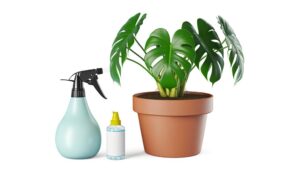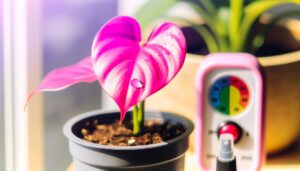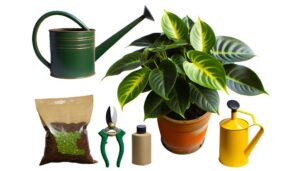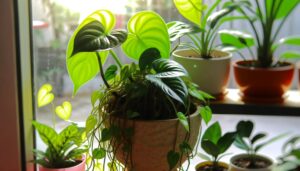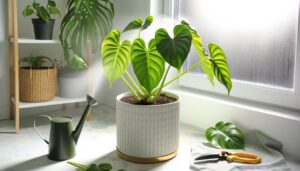How Do I Care for a Philodendron ‘Pink Princess’? Guide!
To care for a Philodendron ‘Pink Princess,’ position it in bright, indirect sunlight to prevent leaf burn. Use well-draining soil with perlite and orchid bark to retain moisture without waterlogging.
Maintain a consistent watering schedule, making sure the top inch of soil dries before re-watering. Keep ambient humidity between 60-80% using humidifiers or pebble trays.
Fertilize biweekly during the growing season with a diluted, balanced N-P-K fertilizer. Prune with sterilized shears to remove damaged foliage and enhance growth.
Monitor for pests, applying insecticidal soap if necessary. Maintaining these conditions will ensure optimal plant health and growth.
For in-depth insights, continue exploring specific care aspects.
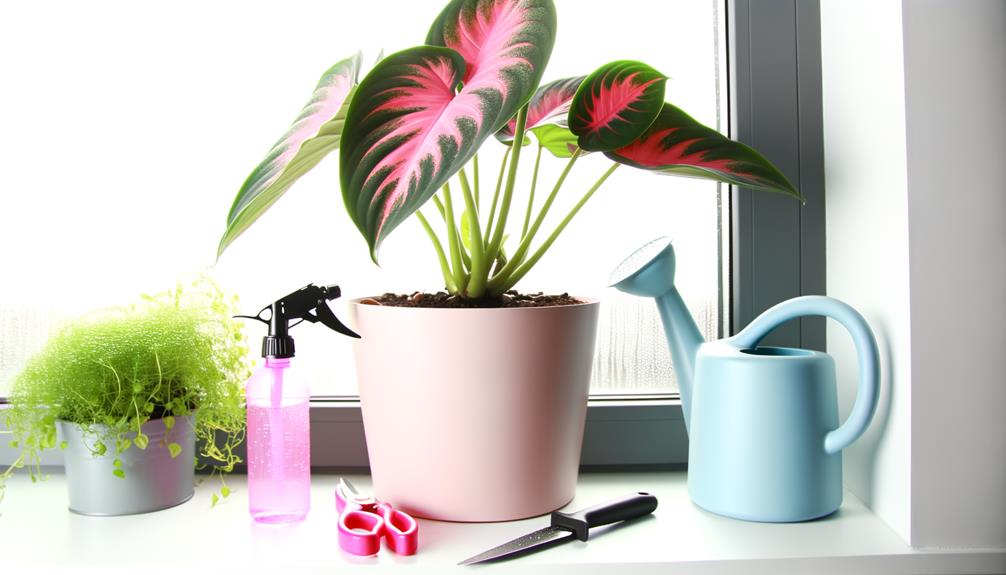
Key Takeaways
- Place in bright, indirect sunlight to avoid leaf burn and promote healthy growth.
- Water when the top inch of soil is dry, using well-draining soil to prevent root rot.
- Maintain humidity levels between 60-80% using humidifiers or pebble trays.
- Fertilize bi-weekly in spring and summer with a diluted 20-20-20 water-soluble fertilizer.
- Prune with sterilized shears to remove damaged leaves and stimulate new growth.
Light Requirements
Proper light exposure is essential for the best growth and variegation of Philodendron ‘Pink Princess’, as it thrives in bright, indirect sunlight.
Best light conditions involve placing the plant near east or north-facing windows, where it receives filtered light without direct exposure to intense solar radiation.
Avoid direct sunlight, which can cause leaf burn and diminish the vibrant pink variegation. Utilize sheer curtains or shade cloths to diffuse harsh sunlight if necessary. Artificial grow lights, such as fluorescent or LED, can supplement natural light, guaranteeing a photoperiod of 12-14 hours daily.
Regularly rotate the plant to promote even growth and prevent phototropism. Monitoring light intensity with a lux meter can further guarantee the plant receives adequate illumination.
Watering Needs
Philodendron ‘Pink Princess’ requires specific moisture levels to maintain ideal growth, necessitating well-draining soil to prevent waterlogged conditions. Overwatering poses significant risks, including root rot and fungal infections, therefore soil moisture should be monitored regularly.
Watering frequency should be adjusted based on ambient humidity and temperature, ensuring the top inch of soil remains moderately moist without becoming saturated.
Proper Moisture Levels
Maintaining ideal moisture levels for the Philodendron ‘Pink Princess’ involves ensuring the soil remains consistently moist but not waterlogged, which can be achieved through a balanced watering schedule and proper drainage.
This plant thrives with soil that is well-draining yet retains moisture, necessitating the use of a potting mix containing perlite or orchid bark. Regularly check the top inch of soil; if dry, water thoroughly until excess drains out. Utilize pots with drainage holes to prevent water accumulation.
| Parameter | Recommendation |
|---|---|
| Soil Moisture | Consistently moist, not soggy |
| Soil Type | Well-draining, retains moisture |
| Watering Frequency | When top inch is dry |
| Drainage | Essential, use pots with holes |
| Additives | Perlite, orchid bark for aeration |
Adopt these practices to optimize plant health and growth.
Avoid Overwatering Risks
Securing the Philodendron ‘Pink Princess’ with appropriate watering involves not only maintaining consistent moisture levels but also understanding the critical need to prevent overwatering, which can lead to root rot and other detrimental conditions.
Overwatering risks arise from waterlogged soil, impairing oxygen availability to the root system. To mitigate this, utilize a well-draining substrate, such as a mix of peat, perlite, and orchid bark. Implement a pot with drainage holes to facilitate excess water escape.
Monitor soil moisture using a moisture meter or by inserting a finger approximately two inches into the soil; it should feel dry before the next watering. Guarantee ambient humidity remains around 60%, enhancing plant health without saturating the soil.
Watering Frequency Tips
Best watering frequency should be determined by assessing the plant’s growth stage, environmental conditions, and soil moisture levels to avoid both underwatering and overwatering.
During the active growth phase, typically spring and summer, Philodendron ‘Pink Princess’ requires more frequent hydration. Utilize a soil moisture meter or conduct the finger test, inserting your finger 1-2 inches into the soil. Water when the top inch feels dry, guaranteeing thorough saturation while avoiding waterlogging.
In dormancy periods, usually fall and winter, reduce watering frequency to prevent root rot. Additionally, consider ambient humidity, as high humidity levels can decrease watering needs.
Implementing these techniques ensures prime hydration, promoting healthy growth and vibrant variegation in your Philodendron ‘Pink Princess.’
Humidity Levels
Maintaining ideal humidity levels is vital for the health of a Philodendron ‘Pink Princess’, with an ideal range between 60-80% relative humidity.
Employing humidity-boosting techniques such as misting, using a humidifier, or placing the plant on a pebble tray can greatly enhance environmental conditions.
Monitoring for signs of low humidity, such as browning leaf edges and reduced growth, is important for timely intervention.
Ideal Humidity Range
The Philodendron ‘Pink Princess’ thrives in a relative humidity range of 60-80%, which mimics its native tropical environment. Maintaining this specific range is essential for optimal physiological processes, including transpiration and nutrient uptake.
Relative humidity below 60% can result in desiccation of leaf margins and reduced variegation, whereas levels exceeding 80% may promote fungal and bacterial growth. Utilize a hygrometer to monitor ambient humidity accurately.
Positioning the plant in areas with naturally higher humidity, such as bathrooms or kitchens, can be beneficial. Additionally, make sure that air circulation is adequate to prevent microbial proliferation.
Consistently following these humidity parameters will foster robust growth, vibrant variegation, and overall plant health, thereby enhancing your caregiving effectiveness.
Humidity-Boosting Techniques
Employing various humidity-boosting techniques, such as using a humidifier, misting the leaves, or placing a water-filled pebble tray near the plant, can effectively elevate the ambient moisture levels to suit the Philodendron ‘Pink Princess’. Optimal humidity levels for this tropical plant range from 60% to 80%, necessitating precise control methods.
A digital hygrometer is recommended to monitor humidity levels accurately. Misting should be performed with distilled water to avoid mineral buildup on leaves. Additionally, clustering plants together can create a microenvironment with higher humidity due to collective transpiration.
| Technique | Description |
|---|---|
| Humidifier | Provides consistent moisture output |
| Misting | Increases leaf surface moisture |
| Pebble Tray | Evaporates water to raise local humidity |
| Grouping Plants | Creates a micro-humid environment |
| Digital Hygrometer | Monitors and displays ambient humidity levels |
Signs of Low Humidity
Recognizing signs of low humidity is crucial for the health of the Philodendron ‘Pink Princess’, as insufficient moisture levels can lead to leaf curling, brown edges, and stunted growth. Low humidity can compromise the plant’s ability to perform essential physiological processes such as transpiration and photosynthesis.
To guarantee ideal conditions, monitor for the following indicators:
- Leaf Curling: Margins of leaves may curl inward, indicating desiccation.
- Brown Leaf Edges: Necrosis can occur along the periphery of leaves due to cellular dehydration.
- Reduced Growth Rate: Insufficient humidity impedes cellular expansion, thereby stunting growth.
- Drooping Leaves: A lack of turgor pressure results in leaves appearing wilted.
- Leaf Shedding: Premature abscission of leaves can be a defense mechanism against water loss.
Maintain humidity levels above 60% to preserve plant health.
Ideal Temperature
Maintaining an ideal temperature range between 65-80°F (18-27°C) is essential for ensuring the healthy growth and vibrant coloration of a Philodendron ‘Pink Princess.’
This species is highly sensitive to temperature fluctuations; it is important to avoid exposing the plant to temperatures below 60°F (15°C) or above 85°F (29°C). Prolonged exposure to temperatures outside the best range can cause stress, leading to leaf discoloration and stunted growth.
Position the plant away from drafty windows, air conditioning vents, and direct heat sources to maintain a stable environment.
Additionally, using a digital thermometer to monitor room temperature can provide precise control, ensuring that the Philodendron ‘Pink Princess’ thrives in its designated habitat.
Soil Type
A well-draining, aerated soil mixture rich in organic matter is crucial for the best health of a Philodendron ‘Pink Princess.’ This plant thrives in a substrate that ensures sufficient oxygenation while retaining moisture without becoming waterlogged.
A balanced soil mix should have components that facilitate drainage, aeration, and nutrient retention.
- Perlite: Enhances aeration and drainage, reducing soil compaction.
- Peat Moss: Retains moisture and provides necessary organic matter.
- Pine Bark: Adds texture and promotes air space within the soil matrix.
- Activated Charcoal: Helps filter impurities and keep the root zone healthy.
- Composted Leaf Mold: Enriches the soil with nutrients and improves its structure.
These components create an ideal environment for root development and overall plant well-being.
Fertilizing Schedule
Ensuring that your Philodendron ‘Pink Princess’ receives the appropriate nutrients is as crucial as providing it with the right soil, requiring a well-structured fertilizing schedule.
Apply a balanced, water-soluble fertilizer with an N-P-K ratio of 20-20-20 every other week during the growing season (spring and summer). Dilute the fertilizer to half the recommended strength to avoid nutrient toxicity.
In the dormant periods (fall and winter), reduce fertilization to once a month, ensuring minimal nutrient supply without encouraging excessive growth. Monitor the plant for signs of nutrient deficiencies, such as chlorosis or stunted growth, and adjust the fertilization frequency accordingly.
Regularly flushing the soil with water can prevent salt buildup, ensuring ideal nutrient uptake and plant health.
Pruning Tips
To promote healthy growth and maintain an aesthetically pleasing shape, it is essential to trim your Philodendron ‘Pink Princess’ using sterilized pruning shears. Regular trimming encourages robust development and prevents the plant from becoming leggy.
- Sanitize Tools: Disinfect pruning shears with isopropyl alcohol to prevent pathogen transmission.
- Identify Nodes: Cut above a leaf node to stimulate new growth at that point.
- Remove Damaged Leaves: Excise any yellowing or diseased foliage to enhance overall plant health.
- Shape Control: Trim overgrown stems to maintain structural integrity and desired form.
- Timing: Prune during the growing season, typically spring and summer, for best recovery and growth.
Pruning should be precise and deliberate to ensure the plant flourishes.
Pest Control
Efficient pest management for Philodendron ‘Pink Princess’ involves consistent monitoring and early identification of common pests such as spider mites, aphids, and mealybugs. Examine the foliage, especially the undersides of leaves, using a magnifying glass for improved detection.
Implement a methodical approach to pest elimination by first isolating the affected plant to prevent cross-contamination. Use insecticidal soap or neem oil, applying it evenly to the infested areas. For severe infestations, consider systemic insecticides containing imidacloprid or spinosad.
Maintain sufficient air circulation and sustain ideal humidity levels between 40-60% to discourage pest proliferation. Regularly cleanse leaves with a moist cloth to eliminate dust and potential pests. Adhering to these steps will safeguard the health and visual appeal of your Philodendron ‘Pink Princess’.
Propagation Methods
Maintaining a healthy Philodendron ‘Pink Princess’ also involves understanding and implementing effective propagation methods to expand your collection or share with fellow enthusiasts.
The most reliable method is stem cuttings, which guarantees genetic consistency and healthy growth.
Follow these precise steps:
- Select a healthy stem: Choose a segment with at least one node and a few leaves.
- Sterilize cutting tools: Use isopropyl alcohol to prevent pathogen transmission.
- Make the cut: Slice just below a node using a sharp, sterile blade.
- Rooting medium: Place the cutting in water or a moist substrate like sphagnum moss.
- Environmental conditions: Maintain high humidity and indirect sunlight to encourage root development.
These steps ensure successful propagation and vibrant growth.
How Big Do Pink Princess Philodendrons Get?
Pink Princess Philodendrons can grow up to 2-4 feet in height and spread about 2-3 feet wide when grown indoors under optimal conditions. The size can vary based on factors such as light, humidity, and overall care.
Best Window for Pink Princess Philodendron
The best window for a Pink Princess Philodendron is an east or west-facing window. These windows provide bright, indirect light, which is ideal for promoting the vibrant pink variegation without causing leaf burn. If the light is too intense, consider using sheer curtains to diffuse it.
Conclusion
To sum up, the meticulous care of Philodendron ‘Pink Princess’ requires adherence to specific horticultural practices. Best growth is attained through regulated light exposure, precise watering schedules, adequate humidity, and controlled temperatures.
The plant thrives in nutrient-rich, well-draining soil and benefits from a systematic fertilization regimen. Pruning is essential for maintaining aesthetic appeal, while vigilant pest control guarantees plant health.
Propagation, though intricate, can be achieved with careful technique, securing the perpetuation of this botanical specimen.


